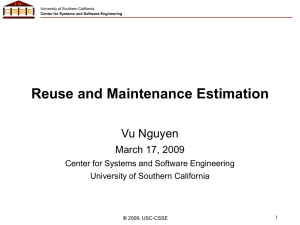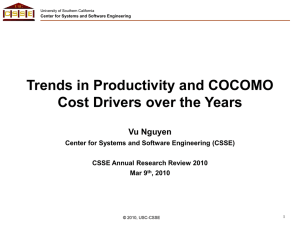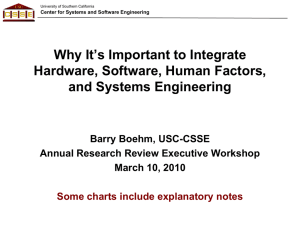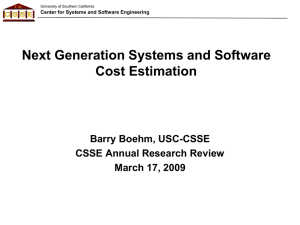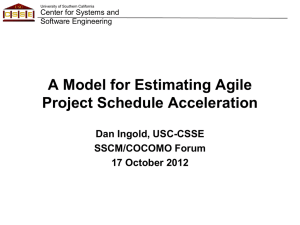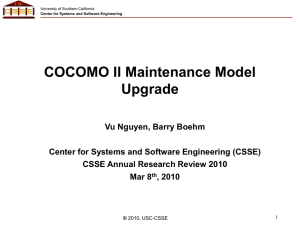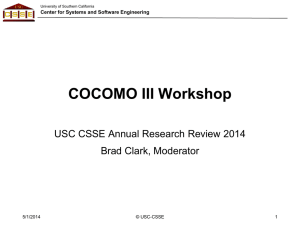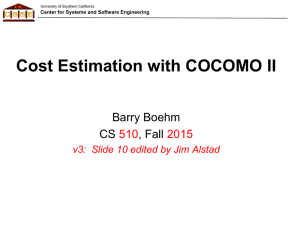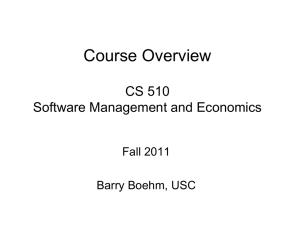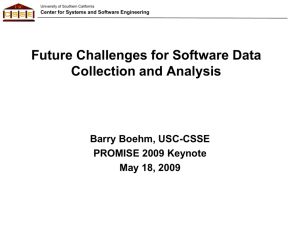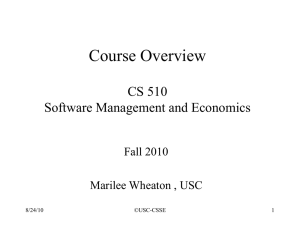SLOC and Size Reporting - Software Engineering II
advertisement
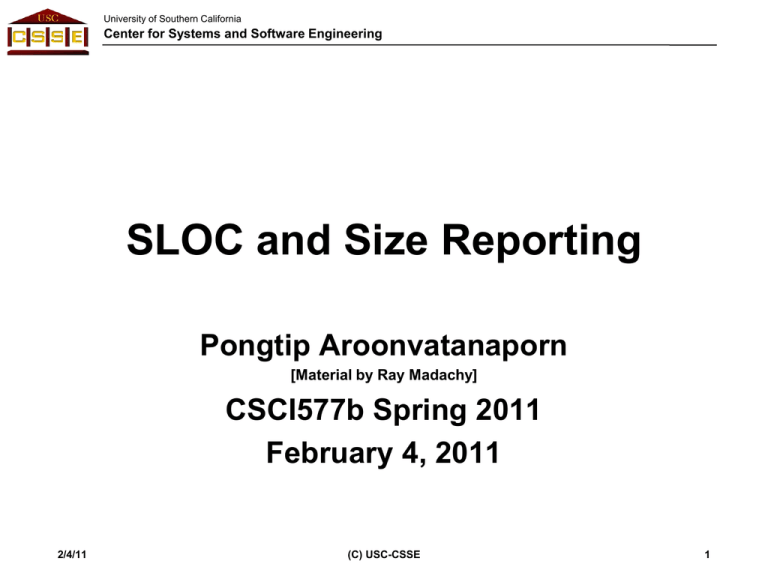
University of Southern California
Center for Systems and Software Engineering
SLOC and Size Reporting
Pongtip Aroonvatanaporn
[Material by Ray Madachy]
CSCI577b Spring 2011
February 4, 2011
2/4/11
(C) USC-CSSE
1
University of Southern California
Center for Systems and Software Engineering
Outline
• Size Reporting Process
• SLOC Counting Rules
• Reused and Modified Software
– COCOMO Model
• The Unified Code Count tool
• Conclusion
2/4/11
(C) USC-CSSE
2
University of Southern California
Center for Systems and Software Engineering
Goal of Presentation
• Understanding the size data required at IOC
• Why?
– Important historical data on 577 process
• Process performance
– Can be used for COCOMO calibration
– Specially calibrated COCOMO for 577
• Current COCOMO utilize 200+ projects to
calibrate
– Help identify COCOMO deficiencies and
additional needs
2/4/11
(C) USC-CSSE
3
University of Southern California
Center for Systems and Software Engineering
Size Reporting Process
• Determine what you produced and quantify
it
– Code developed new, reused, and modified
– Apply code counter to system modules
– Apply reuse parameters to all reused and
modified code to get equivalent size
2/4/11
(C) USC-CSSE
4
University of Southern California
Center for Systems and Software Engineering
Size Reporting Process
• Identify any software not counted
• Provide as much background as possible
– Someone can follow up and fill in the gaps
– Acceptable to use function point counts as a
last resort
• Problem with counting COTS code
– Provide COCOTS inputs if doing COTSintensive development
– COTS-development contributes the majority of
effort, but size cannot be counted
2/4/11
(C) USC-CSSE
5
University of Southern California
Center for Systems and Software Engineering
Size Reporting Process
• Finalizing the report
– Add up all equivalent lines of code
– The same top-level size measure that COCOMO
uses
• Count by modules
– The modules should be consistent with your
COCOMO estimation
– Otherwise, nearly impossible to compare with
estimates
2/4/11
(C) USC-CSSE
6
University of Southern California
Center for Systems and Software Engineering
Lines of Code
• Source lines of code (SLOCs)
– Logical source statements
– NOT physical statements
• Logical source statements
– Data declarations
• Non-executable statements that affect an
assembler’s or compiler’s interpretation
– Executable statements
• Cause runtime actions
2/4/11
(C) USC-CSSE
7
University of Southern California
Center for Systems and Software Engineering
Lines of Code
Example 1
1
2
3
4
5
6
7
8
String[] command =
{
“cmd.exe”,
“/C”,
“-arg1”,
“-arg2”,
“-arg3”
};
Example 2
1
2
3
4
5
6
7
8
int arg1=0; int arg2=4; String ans;
ans = “Answer is”;
System.out.println(ans +arg1+arg2);
LOC = 1
2/4/11
LOC = 5
(C) USC-CSSE
8
University of Southern California
Center for Systems and Software Engineering
SLOC Counting Rules
• Standard definition for counting lines
– Based on SEI definition
– Modified for COCOMO
• When line or statement contains more than
one type
– Classify it as type with highest precedence
2/4/11
(C) USC-CSSE
9
University of Southern California
Center for Systems and Software Engineering
SLOC Counting Rules
Statement type
Includes
1. Executable
Excludes
Declarations
4.
Compiler directives
5.
Comments:
1. Programmed
3. Converted with automated translators
4. Copied or reused without change
5. Modified
6. Removed
6.
On their own lines
7.
On lines with source code
8.
Banners and non-blank spacers
9.
Blank (empty) comments
10.
Blank lines
2/4/11
Includes Excludes
2. Generated with source code generators
2. Non-executable:
3.
How produced
(C) USC-CSSE
10
University of Southern California
Center for Systems and Software Engineering
SLOC Counting Rules
Origin
Includes
1. New work: no prior existence
Excludes
2. Prior work: taken or adapted from:
3.
A previous version, build, or release
4.
Commercial, off-the-shelf software (COTS), other than libraries
5.
Government furnished software (GFS), other than reuse libraries
6.
Another product
7.
A vendor-supplied language support library (unmodified)
8.
A vendor-supplied operating system or utility (unmodified)
9.
A local or modified language support library or operating system
2/4/11
(C) USC-CSSE
11
University of Southern California
Center for Systems and Software Engineering
Reused and Modified Software
• Also categorized as “adapted software”
• Problem:
– Effort for adapted software is not the same as
for new software
– How to compare effort for reused and modified
software with new software?
• Counting approach:
– Convert adapted software into equivalent size of
new software
2/4/11
(C) USC-CSSE
12
University of Southern California
Center for Systems and Software Engineering
Reuse Size-Cost Model
Data on 2954
NASA modules
[Selby,1988]
1.0
1.0
0.70
0.75
0.55
Does not cross origin
due to cost for
assessing, selecting,
and assimilating
reusable components
~ 5%
Relative
cost
0.5
Usual Linear
Assumption
0.25
0.046
0.25
0.5
0.75
1.0
Amount Modified
• Non-linear because small modifications generation
disproportionately large costs
• Cost of understanding software
• Relative cost of interface checking
2/4/11
(C) USC-CSSE
13
University of Southern California
Center for Systems and Software Engineering
COCOMO Reuse Model
• Non-linear estimation model
– Convert adapted software into equivalent size of
new software
Adaptation
Adjustment
Factor
Percent
Design
Modified
Percent
Code
Modified
Percent of effort for
integration and test of
modified
AAF = 0.4(DM)+ 0.3(CM)+ 0.3(IM)
Equivalent
SLOC
ASLOC[AA + AAF(1+ 0.02(SU)(UNFM )]
ESLOC =
, AAF £ 0.5
100
ASLOC[AA + AAF + (SU)(UNFM )]
ESLOC =
, AAF > 0.5
Assessment and
100 Software
Unfamiliarity
Assimilation Effort
2/4/11
Adaptation
Adjustment
Multipliers
(AAM)
Understanding
(C) USC-CSSE
14
University of Southern California
Center for Systems and Software Engineering
Reuse Model Parameters
• DM – Percent Design Modified
– Percentage of adapted software’s design
modified to fit it to new objectives
• CM – Percent Code Modified
– Percentage of “reused” code modified to fit it to
new objectives
• IM – Percentage of effort for integration and
test of modified software
– Relative to new software of comparable size
IM = 100 * I&T Effort (modified software) / I&T Effort (new software)
2/4/11
(C) USC-CSSE
15
University of Southern California
Center for Systems and Software Engineering
Reuse Model Parameters (AA)
• Assessment & Assimilation Effort
– Effort needed to:
• Determine whether fully-reused software is
appropriate
• Integrate its description into overall product
description
AA Increment
2/4/11
Level of AA Effort
0
None
2
Basic module search and documentation
4
Some module Test and Evaluation (T&E), documentation
6
Considerable module T&E, documentation
8
Extensive module T&E, documentation
(C) USC-CSSE
16
University of Southern California
Center for Systems and Software Engineering
Reuse Model Parameters (SU)
• Software Understanding Effort
– When code isn’t modified (DM=0, CM=0), SU=0
– Take subjective average of 3 categories
Very Low
Structure
Very low
cohesion, high
coupling,
spaghetti code.
Application
Clarity
Low
Nominal
Very High
Reasonably wellstructured; some
weak areas.
High cohesion, low
coupling.
Strong modularity,
information hiding in
data / control
structures.
No match
Some correlation
between
between program and
program and
application.
application world
views.
Moderate
correlation
between program
and application.
Good correlation
between program
and application.
Clear match between
program and
application world-views.
SelfDescriptiveness
Obscure code;
documentation
missing, obscure
or obsolete
Some code
commentary and
headers; some useful
documentation.
Moderate level of
code commentary,
headers,
documentations.
Good code
commentary and
headers; useful
documentation;
some weak areas.
Self-descriptive code;
documentation up-todate, well-organized,
with design rationale.
SU Increment to
ESLOC
50
40
30
20
10
2/4/11
Moderately low
cohesion, high
coupling.
High
(C) USC-CSSE
17
University of Southern California
Center for Systems and Software Engineering
Reuse Model Parameters (UNFM)
• Unfamiliarity
– Effect of programmer’s unfamiliarity with
software
UNFM Increment
2/4/11
Level of Unfamiliarity
0.0
Completely familiar
0.2
Mostly familiar
0.4
Somewhat familiar
0.6
Considerably familiar
0.8
Mostly unfamiliar
1.0
Completely unfamiliar
(C) USC-CSSE
18
University of Southern California
Center for Systems and Software Engineering
Improved Reuse Model
• Unified model for both reuse and maintenance
– New calibration performed by Dr. Vu Nguyen
• SLOC modified and deleted are considered to be
equivalent to SLOC added
0.3 1
AAF = 0.4(DM)+CM + 0.3(IM)
é æ AAF ö2 ù
ASLOC[AA + AAF ê1- ç1÷ ú(SU)(UNFM )
êë è 100 ø úû
ESLOC =
, AAF £1
100
ASLOC[AA + AAF + (SU)(UNFM )]
ESLOC =
, AAF >1
100
2/4/11
(C) USC-CSSE
19
University of Southern California
Center for Systems and Software Engineering
Reuse Parameter Guidelines
Code Category
New
- all original software
Adapted
- changes to pre-existing
software
Reused
- unchanged existing
software
COTS
- off-the-shelf software
(often requires new glue
code as a wrapper around
the COTS)
2/4/11
Reuse Parameters
IM
not applicable
DM
CM
0% - 100%
normally > 0%
0+% - 100% usually >
DM and must be >
0%
0%
0%
0%
0%
(C) USC-CSSE
0% - 100+%
IM usually
moderate; but
can be > 100%
0% - 100%
rarely 0%, but
could be very
small
0% - 100%
AA
SU
UNFM
0% – 8%
0% - 50%
0-1
0% – 8%
not applicable
0% – 8%
not applicable
20
University of Southern California
Center for Systems and Software Engineering
Data Collection
2/4/11
(C) USC-CSSE
21
University of Southern California
Center for Systems and Software Engineering
Data Collection
• Refer to COCOMO model definition for details on
various parameters
– DM, CM, IM, etc
• Indicate the counting method you used
– Manual approach?
– Automated?
• Available Code Counters
– CSSE Code Counter: UCC
– Code Counter developed as part of CSC 665 Advanced
Software Engineering project
– Third party. But make sure that the counting rules are
consistent.
2/4/11
(C) USC-CSSE
22
University of Southern California
Center for Systems and Software Engineering
The Unified Code Count Tool
• Developed at USC-CSSE
• Based on the counting rule standards
established by SEI
• Evolved to count all major languages
including web platforms
• Can be used to determine modified code
(changed and deleted)
– Use this data to find equivalent “new” code
2/4/11
(C) USC-CSSE
23
University of Southern California
Center for Systems and Software Engineering
Conclusion
• Software sizing and reporting is more than
just simple line counting
– Finding actual effort based on equivalent sizing
– Only logical source code contributes to effort
• Accurate reporting is essential
– For research purposes
– Process performance evaluation and calibration
– Future planning and productivity predictions
• Give background on software pieces not
counted
2/4/11
(C) USC-CSSE
24
